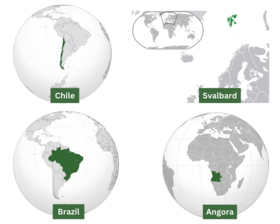A gas hydrate pingo is a submarine dome structure formed by the accumulation of gas hydrates under the seafloor.
Formation and Location

Gas hydrate pingos contain reservoirs of gas hydrates, which are crystallized gas particles. The crystallized gas particles form when a gas particle is surrounded by water molecules. The water molecules create a lattice structure that encages the gas molecule when at low temperatures and high pressures (around 15 megapascals). Most gas hydrates contain methane, while other rare gas hydrates contain hydrogen sulfate or carbon dioxide. These submarine pingos are found along continental margins and in polar regions, especially in locations with methane seeps. These locations often have permafrost that is below sea level, but this permafrost is not required for gas hydrate pingo formation. An example of these different methods of pingo formation can be found on the coast of Angola, which formed from methane seeps, and off the Western Svalbard Margin, which formed from sub-sea permafrost. Other examples of gas hydrate pingos can be found along the Chilean and Brazilian margin.

Effects on Climate and Environment

Gas hydrates have been studied as a possible form of clean energy, as they could serve as additional natural gas reservoirs. However, as global temperature rises, these gas hydrates become unstable, meaning that they could release greenhouse gases into the atmosphere and contribute to global warming. Gas hydrate pingos can also become unstable due to the high seismic activity in their vicinity, since these formations are often along continental margins and other areas of seismic interest.
Gas hydrate pingos and their surrounding regions are hosts to various organisms, including many types of aquatic worms, mussels, clams, marine snails, shrimp and bacteria. Most of these organisms perform methanogenesis as a form of anaerobic respiration. A study in the Norwegian Sea found that gas hydrate pingos were covered by bacterial mats and Polychaete tubeworms that are associated with methane.
References
- ^ Dillon, William P. (2002-01-01), "Gas Hydrate in the Ocean Environment", in Meyers, Robert A. (ed.), Encyclopedia of Physical Science and Technology (Third Edition), New York: Academic Press, pp. 473–486, doi:10.1016/b0-12-227410-5/00276-3, ISBN 978-0-12-227410-7, retrieved 2023-10-27
- ^ Serié, Christophe; Huuse, Mads; Schødt, Niels H. (2012-03-01). "Gas hydrate pingoes: Deep seafloor evidence of focused fluid flow on continental margins". Geology. 40 (3): 207–210. doi:10.1130/g32690.1. ISSN 1943-2682.
- ^ Waage, M.; Portnov, A.; Serov, P.; Bünz, S.; Waghorn, K. A.; Vadakkepuliyambatta, S.; Mienert, J.; Andreassen, K. (February 2019). "Geological Controls on Fluid Flow and Gas Hydrate Pingo Development on the Barents Sea Margin". Geochemistry, Geophysics, Geosystems. 20 (2): 630–650. doi:10.1029/2018GC007930. hdl:10037/14528. ISSN 1525-2027.
- ^ Tinivella, Umberta; Giustiniani, Michela; Vargas Cordero, Ivan de la Cruz; Vasilev, Atanas (October 2019). "Gas Hydrate: Environmental and Climate Impacts" (PDF). Geosciences. 9 (10): 443. doi:10.3390/geosciences9100443. ISSN 2076-3263.
- Murawski, Steven A.; Ainsworth, Cameron H.; Gilbert, Sherryl; Hollander, David J.; Paris, Claire B.; Schlüter, Michael; Wetzel, Dana L.; Technische Universität Hamburg; Technische Universität Hamburg, eds. (2020). Scenarios and responses to future deep oil spills: fighting the next war (Corrected publication ed.). Cham: Springer. ISBN 978-3-030-12962-0.
- ^ Sahling, Heiko; Borowski, Christian; Escobar-Briones, Elva; Gaytán-Caballero, Adriana; Hsu, Chieh-Wei; Loher, Markus; MacDonald, Ian; Marcon, Yann; Pape, Thomas; Römer, Miriam; Rubin-Blum, Maxim; Schubotz, Florence; Smrzka, Daniel; Wegener, Gunter; Bohrmann, Gerhard (August 11, 2016). "Massive asphalt deposits, oil seepage, and gas venting support abundant chemosynthetic communities at the Campeche Knolls, southern Gulf of Mexico". Biogeosciences. 13 (15): 4491–4512. doi:10.5194/bg-13-4491-2016. hdl:21.11116/0000-0001-C29D-3. ISSN 1726-4170.
- Hovland, Martin; Svensen, Henrik (2006). "Submarine pingoes: Indicators of shallow gas hydrates in a pockmark at Nyegga, Norwegian Sea". Marine Geology. 228 (1–4): 15–23. Bibcode:2006MGeol.228...15H. doi:10.1016/j.margeo.2005.12.005.
| Periglacial environment | |||
|---|---|---|---|
| Landforms |
| ||
| Processes | |||
| Soils and deposits | |||
| Biomes and ecotones | |||
| Climate | |||